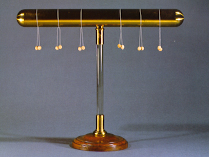
36.4 x 15 x 44
Brass, glass and wood
CAT 1878 : 350
Conductor isolado com pendulos de medula de sabugueiro.
Insulated conductor with elder pith pendulums.
This instrument had numerous uses in electrostatic experiments. It is basically a brass cylinder mounted horizontally on a glass insulator rod fixed on a round wooden base like the one for instrument 128.
For example, if pairs of electrical pendulums made from balls of elder pith are hung along a horizontal cylinder, information on the distribution of electrical charges can be obtained. In these conditions, it can be observed that two elder pith pendulums that are touching when the cylinder is not subjected to the action of an electrically charged body, repel one another when the cylinder is charged. The distribution of the pairs of pendulums along the cylinder shows that the repulsion occurring between the elements of a pair when a charged body is brought close to the end of the cylinder, without touching it, is stronger at the ends and is non existent in the middle.
The two electrical fluids' model, characterised by very subtle behaviour, was used to explain these phenomena for a long time. This theory held that in bodies in their natural state there was an indeterminate amount of subtle, weightless material known as neutral electrical fluid. This fluid was somewhat complex; it was thought to be formed by the combination of two kinds of "molecules", some positive and others negative. When they combined in equal quantities, the body thus formed was in a neutral state. When they joined in unequal amounts, the body was positively or negatively charged, accordingly. With this model, the two fluids could move very quickly through conducting bodies, but were fixed in insulating materials.
In the case of the cylinder under the influence of an electrically charged body, in the context of this model, it was said that the electrical fluid in the influencer attracted the "molecules" of the fluid with the opposite charge to the end it was nearest to and repelled those of the same charge. The presence of these "molecules" of electrical fluid at the ends of the cylinder is indicated by the repulsion of the two elder balls.
The fact that no repulsion was seen in the middle part was explained by there being a combination of equal quantities of "molecules" of the two kinds of fluid.
This model was used for a very long time to explain the behaviour of physical systems; it was, however, made obsolete by the evolution of experimental methods in physics during the 19th century.
It was acquired by the Gabinete de Física in 1864.
Daguin, Pierre-Adolphe, Traité Élémentaire de Physique Théorique et Expérimentale, Paris, 1878, Vol. III, n.º 1589 and n.º 1591.
Jamin, Jules-Célestin, Cours de Physique de l'École polytechnique, Paris, 1863, 20th lesson.